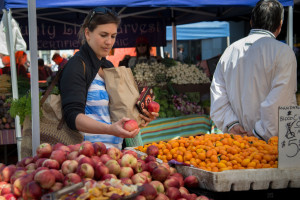>> We are officially in the thick of summer. Temperatures soar into triple digits, women’s magazines are bleating about “beach bodies,” and all I can think about is food. Fresh corn on the cob, crookneck squash and bushels of warm, fat tomatoes… This is bliss. This is what the state of North Carolina does best.
We are officially in the thick of summer. Temperatures soar into triple digits, women’s magazines are bleating about “beach bodies,” and all I can think about is food. Fresh corn on the cob, crookneck squash and bushels of warm, fat tomatoes… This is bliss. This is what the state of North Carolina does best.
North Carolina is 8th in the nation in agricultural production. We are also ranked 10th in the number of farmers markets, with 92 of our 100 counties having at least one. This is great news for veggies gluttons like myself!
Except that not all of us can afford to indulge. Given that only >>39 of North Carolina’s 252 farmers markets accept SNAP/EBT benefits, and even fewer accepting WIC or Senior nutrition program vouchers, many families find themselves at a loss.
With a nearly 19% increase over last year, we now have over 798,000 families receiving SNAP.
Though the debate over costs in farmers markets versus grocery stores rages on, there is no doubt that those dependent on these benefits to feed their families face barriers to access when the farmer’s market in their area does not accept their vouchers. Plus, many people cite >>transportation as the biggest issue when addressing the issues of living in food deserts.
Creating opportunities for access to fresh, healthy foods is a high priority right now. From developmental problems to heart disease, and >>possibly even depression, many of our current public health problems can be traced back to what we nourish ourselves with.
Too often, the burden is placed back on families. It is not only irrational, but irresponsible to >>victim-blame those who are unable to afford the fresh foods so many take for granted. A desire to eat more healthfully does not equate to a capacity to make that happen. Policies and procedures need to be implemented at state and community levels.
Unfortunately, many farmer’s market venues opt not to offer benefits to higher-need families. This is largely due to the money and effort required to initiate the programs. It requires detailed recordkeeping and licensing and >>“brings in too few dollars to make it worthwhile for the market to invest in the staff time required.”
There must be an understanding of the overall benefits to the community and dedicated effort put in to make a food assistance program flourish. Fortunately, the Eat Smart, Move More NC created a >>how-to guide for farmers markets to create and maintain sustainable SNAP/EBT programming.
Individuals and communities can contact their local representatives or market managers and ask what opportunities there are for lower-income families to participate. There are also
>>resources through the NCSU Agricultural Extension program to help get you started.
I may be biased- but there is nothing better than that first bite of the warm tomato sandwich of the season. This is something we should all be able to enjoy, regardless of how we pay for it.
The people who can’t afford to travel to farmers markets, let alone afford the products there, wouldn’t spend $5.00 on 3 tomatoes when they can get 3 jars of Preggo and a box of pasta for the same.
This is a terrific post. Lots of good points. Our organization piloted a voucher project for low-income families to the Siler City Farmer’s market. Unfortunately, lack of transportation was one of the biggest barriers. It was much easier for the families to make a one stop shop to Wal Mart where they could get everything they needed. Not their fault. Totally frustrating. Transportation needs to get involved – public transportation agencies should prioritize routes that allow for access to healthy foods.